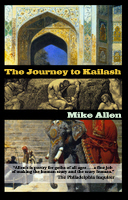 Mike Allen has been, for nine years the editor of the biannual poetry journal Mythic Delirium. He's also edited or co-edited several books, including The Alchemy of Stars (the anthology of all the poems which have won the Science Fiction Poetry Association's Rhysling Award) and the MYTHIC anthologies of fantasy poetry and fiction. He's published four books of poetry, and his latest, Strange Wisdoms of the Dead, was a Philadelphia Inquirer Editor's Choice selection. He's a former president of the Science Fiction Poetry Association and a three-time winner of the Rhysling Award.
Mike Allen has been, for nine years the editor of the biannual poetry journal Mythic Delirium. He's also edited or co-edited several books, including The Alchemy of Stars (the anthology of all the poems which have won the Science Fiction Poetry Association's Rhysling Award) and the MYTHIC anthologies of fantasy poetry and fiction. He's published four books of poetry, and his latest, Strange Wisdoms of the Dead, was a Philadelphia Inquirer Editor's Choice selection. He's a former president of the Science Fiction Poetry Association and a three-time winner of the Rhysling Award.His newest book, The Journey to Kailash, was published by Norilana Books as part of their Curiosities series. It is a three section book, each section about 30-40 pages. These three sections create a vivid journey for the reader through fantastic, often dark, stories.
The first section, "misfortune when he leaves: his shadows grow to meet her," seems very fantasy oriented. For example, the primary and eponymous poem of the collection begins
When Ganesh marries my mother,
I am 18, my own man
in the eyes of the law; but barely a zygote
in his eyes. He calls me spermling
the first time we speak in private;
the poem continues through a step-father/son relationship, and journeys into the territory of what it might mean, in this day and age, to marry a god.
Perhaps my favorite poem of the section is "Giving Back to the Muse," which is a lesson in sacrifice, or love, or something else, perhaps... It begins:
She wears a necklace of knives and eyes,
a sash sewn from flags and faces,
boots welded from bomb fragments,
a belt of hangman’s rope.
and gets even more juicy as the poem rolls forward.
The second section of The Journey to Kailash is "as the stars die, sad whispers warm the breeze," which seems very science fiction oriented. In "Manifest Density," we colonize the universe, bringing "Slurpee cups and no U-turns" to the brink of extinction. In "Black Holes Hold Their Breath," the speaker responds to a comment made by Stephen Hawking concerning black holes and time travel. "retrovirus" takes iconic figures and creates a nightmarish world of 1950's imagery. However, the uninitiated reader should not be afraid. Even though these poems are scientific in nature, and even though Allen drops a few S-bombs (science words that need googling), he keeps the poems extremely accessible, and any reader will be able to connect with the characters and smile or shudder along with the stories told.
The third section of the book is "staring down the sun: the end he never sees," is a more surrealistic series, the majority of which is focused on artists, the worlds they created in their art and the events that inspired them, from "Escher's Bed" to "Klee's Garden" to "O'Keefe's Bones." This is one of the more difficult sections of the book, not in terms of accessibility, but in terms of tone and heaviness. This is a very resonant section, and readers should absorb Allen's words slowly if they are to survive.
The Journey to Kailash is not the book for every reader, certainly. There are elements of the fantastic, elements of science fiction, even elements of surrealism all rubbing against each other. There are times when the disparity seems too great, and this becomes a collection of three chapbooks, but Allen manages to tie it all together, whether through a recurring image or the evocative mood of the poems. In this bitter season of negative degree weather, Mike Allen's The Journey to Kailash is a wonderful book to accompany a pot of tea before of a smoldering fire.

No comments:
Post a Comment